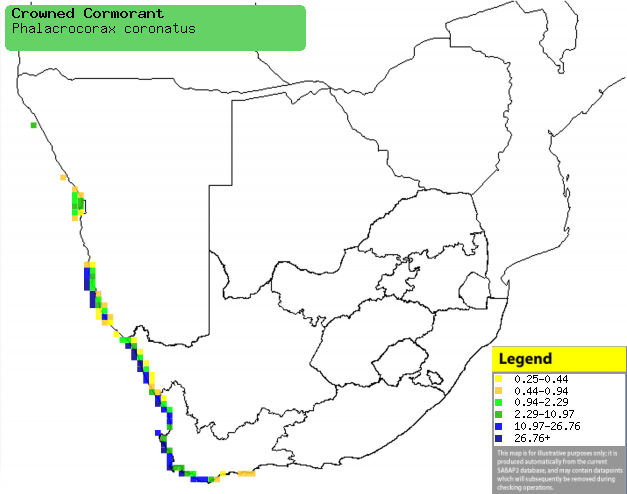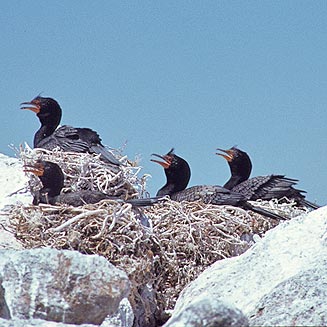Phalacrocorax coronatus (Crowned
cormorant)
Kuifkopduiker [Afrikaans];
Kroonaalscholver [Dutch]; Cormoran couronné [French]; Wahlbergscharbe [German];
Corvo-marinho-coroado [Portuguese]
Life
> Eukaryotes >
Opisthokonta
> Metazoa (animals) >
Bilateria >
Deuterostomia > Chordata >
Craniata > Vertebrata (vertebrates) > Gnathostomata (jawed
vertebrates) > Teleostomi (teleost fish) > Osteichthyes (bony fish) > Class:
Sarcopterygii (lobe-finned
fish) > Stegocephalia (terrestrial
vertebrates) > Tetrapoda
(four-legged vertebrates) > Reptiliomorpha > Amniota >
Reptilia (reptiles) >
Romeriida > Diapsida > Archosauromorpha > Archosauria >
Dinosauria
(dinosaurs) > Saurischia > Theropoda (bipedal predatory dinosaurs) >
Coelurosauria > Maniraptora > Aves
(birds) > Order: Ciconiiformes
>
Family: Phalacrocoracidae
Distribution and habitat
Endemic to the west coast of southern Africa, occurring rocky
areas of coast the coastline and offshore islands, while large absent from
freshwater habitats.
|
 |
|
Distribution of Crowned cormorant in southern Africa,
based on statistical smoothing of the records from first SA Bird Atlas
Project (©
Animal Demography unit, University of
Cape Town; smoothing by Birgit Erni and Francesca Little). Colours range
from dark blue (most common) through to yellow (least common).
See here for the latest distribution
from the SABAP2. |
Predators and parasites
It has been recorded as prey of
Arctocephalus pusillus (Cape fur seal).
Movements and migrations
Largely sedentary, although juveniles disperse
quite far from their parent's territory.
Food
It mainly eats klipfish, doing most of it foraging in rock
pools and in the breaking waves, pursuing its prey underwater in bouts of
roughly 7-59 seconds. Its jaw is adapted to handling slow-moving,
bottom-dwelling fish, as it struggles to catch more fast moving prey. The following food items have been recorded
in its diet:
- Fish
- Clinus superciliosus (Super klipfish)
- Syngnathus (pipefish)
- Chaloderma capito (Looseskin blenny)
- Spicara axillaris (Windtoy)
- Heteromycteris capensis (Cape sole)
- Invertebrates
- crustaceans
- Palaemon pacificus (Sand shrimp)
- isopods
- amphipods
- molluscs
- polychaete worms
- Sabellastarte longa (Giant fanworm)
Breeding
- Monogamous, colonial nester, nesting in small colonies with less than 30
nests, often within a larger colony of other seabirds, herons and egrets.
The male displays at his nest site, puffing its feathers and rapidly jerking
his head backward and forward.
 |
|
| Crowned cormorants on nests. [photo
H. Robertson ©] |
|
- The nest is mainly built by the female, consisting of a platform of
sticks, dry seaweed, feathers and bones, often stained pink with guano. It
is typically placed on an island or some other site which is inaccessible to
mammalian predators, such as a cliff, ledge, wrecked ship, boulder, moored
boat, pier or rocky outcrop.
- Egg-laying season is year-round, peaking from September-March.
- It lays 1-5 eggs, which are incubated by both sexes for 21-23 days.
- The chicks leave the nest at about 12 days old for the rocks and sea
adjacent to the colony, taking their first flight at roughly 35 days old and
becoming fully independent about 10-25 days later.
Threats
Near-threatened due to its small population and
dependence on conservation efforts.
References
-
Hockey PAR, Dean WRJ and Ryan PG 2005. Roberts
- Birds of southern Africa, VIIth ed. The Trustees of the John Voelcker
Bird Book Fund, Cape Town.
|
